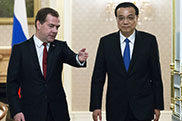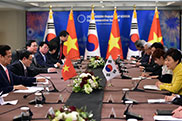 Thinkstock
Thinkstock
Article
Diminished involvement from the United States has left a void in the region. How it is being filled is clearly explained in the Bible.
Learn the why behind the headlines.
Subscribe to the Real Truth for FREE news and analysis.
Subscribe NowA map of Southeast Asia after World War I looks utterly different from today. On it, you would find the Dutch East Indies (modern-day Indonesia) and French Indochina (now Vietnam, Laos and Cambodia). In addition, Singapore, Malaysia and Burma (today’s Myanmar) were all under the British crown. Many other island nations and major seaports were also under European control.
While most Western nations pulled out of the region soon after WWII, the United States still had a presence there through its alliance with the Philippines.
In the following decades, the collection of 11 Southeast Asian nations located between China and Australia found itself in the Cold War between the United States and Soviet Union, with both powers vying for influence.
After the collapse of the USSR, the U.S. pulled back as there was no major reason to continue heavy-handed involvement there.
From the 1990s on, Southeast Asia found itself free from European control as well. Of course, life went on. Yet the loss of Western economic, military and political support pushed countries in the region to look for help closer to home.
While other nations in the area such as Japan and South Korea have helped fill the void left by the U.S., it is increased ties with China that have been most notable. Given past icy relations between the nations of Southeast Asia and their neighbor to the north, the recent level of cooperation has been unforeseen.
A report from The Asia Pacific Journal discussed China’s rising profile in the area: “Particularly since the turn of the century, China’s economic success has enabled it to pursue a greater role on the international stage, backing up its claims to regional and global leadership with growing economic and military might. Nowhere is China’s presence more keenly felt than within Southeast Asia, where increasing Chinese activism is met with a combination of both enthusiasm and significant trepidation.”
Beijing’s influence in Southeast Asia has sparked a reaction from Washington. In 2013, the White House announced a pivot to Asia—with the aim to shift economic, diplomatic and military resources back to the region from other parts of the world.
But China, Japan and South Korea have already filled the power void. While the U.S. clearly wants back in, it may be too late—a new Asia is emerging.
The Business Standard described how the entire region is reinventing itself: “Strategically, traditional US roles and habits are being altered compared to, say, 10 years ago. And the Asia that is likely to emerge 10 years from now will be very different from that with which Americans have grown comfortable.”
What will Southeast Asia’s role be in this new Asia? Does its growing relationship with China and others have implications?
The answer to these questions are more important than you may realize.
Southern Ocean
The motives for foreign interest in Southeast Asia—which includes Brunei, Cambodia, East Timor, Indonesia, Laos, Malaysia, Myanmar (aka Burma), the Philippines, Singapore, Thailand and Vietnam—are obvious. Together, it has a gross domestic product of more than $2.2 trillion and a total population of 620 million. Its vast territory covers five million square miles of land and sea.
Most of these nations appear in headlines alone and are rarely seen as a collective unit. While China refers to the region as Nanyang (Chinese for “Southern Ocean”), they clearly are not just a collection of obscure, tiny island countries.
Take Indonesia, Southeast Asia’s largest nation and home to the world’s largest population of Muslims in one country. Its territory would stretch beyond the west-east borders of the U.S. if superimposed on top of it. Laos is comparable in size to the United Kingdom and Myanmar is larger than France.
Even Southeast Asia’s smaller countries make a sizeable impact. Singapore, which is about 3.5 times the size of Washington, D.C., is quite prosperous. The former British territory is a high-tech, urbanized commercial hub with glittering skyscrapers and a thriving port. It is one of four “Asian Tigers” (with the others being Hong Kong, South Korea, and Taiwan), which are all states or territories that have developed into advanced or high-income economies.
The nation of Brunei, which is about the size of the U.S. state of Delaware, is an oil and natural-gas-rich country. Despite some financial setbacks, Brunei still has one of the highest standards of living in the world. It and Singapore boast the two highest Human Development Indices—a measure of human development based on life-expectancy, education and income—in all of Southeast Asia. The two also rank highly in this category among all nations of the world. (Singapore is ninth and Brunei 30th.)
The Philippines is another prominent nation in the region, in large part because it is one of the few places in Southeast Asia where the relationship with the United States has remained strong. America provides significant financial and security support in exchange for a U.S. military presence in the region.
Yet Southeast Asia’s most important asset is its location. Its mainland is a peninsula wedged between India and China—making the area among the most densely populated in the world. The remaining portion of the territory is a string of large island chains. They create a gateway between East Asia—consisting of Japan, Korea and many of China’s most populous cities—and Africa and Europe to the west.
Given these geostrategic qualities, the region’s assets include a large consumer base and labor pool as well as an economical means for goods to traverse in and throughout the area.
Yet these strengths come at a price. Southeast Asia must rely on others for economic prosperity. Eighty percent of the area’s trade is done with nations outside the region and industries that employ their citizens are mostly foreign owned.
As a thoroughfare for cargo bound for various parts of the globe, the region’s economy thrives when there are products to ship. It is estimated that a quarter of the world’s goods pass through Southeast Asian waterways, including the Strait of Malacca, a narrow, 500-mile shipping lane connecting the Indian Ocean to the South China Sea. One-third of the world’s global crude oil and over half of its liquefied natural gas pass through the area, according to the U.S. Energy Information Administration. The entire region is heavily reliant on global demand, which means its prosperity is inherently dependent on others.
 Alexander Zemlianichenko/AFP/Getty Images
Alexander Zemlianichenko/AFP/Getty ImagesThe territory also looks to others militarily. Proximity to the surrounding nations of Pakistan, India, China, North Korea and Russia—five of the world’s nine total nuclear states—increases the region’s strategic military importance. As a result, many Southeast Asian countries are supported by the more powerful militaries of the world seeking to establish a presence there. For instance, the U.S. has numerous military bases and installations scattered throughout it.
Southeast Asia’s inherent need for outside support is the reason it has been extremely susceptible to governance from the outside. Therefore, to ensure their nations are not taken advantage of, leaders in the region have often banded together.
Stepping Stone to Unity
In the late 1960s, the major nations of the region formed an alliance known as the Association of Southeast Asian Nations or ASEAN (pronounced AH-see-ahn). It looked to foster regional integration similar to the European Union and the African Union.
Two main goals of ASEAN are increased integration among its 10 member states (East Timor did not join) and to encourage citizens to embrace a regional identity. The idea was to present themselves as a united region to carry more clout when negotiating with more powerful nations.
Over its tenure, ASEAN has had some successes, including effectively engaging more powerful neighbors such as China, Japan and Korea. Yet Southeast Asia has not been able to forge a clear-cut regional identity—in fact, the group has never clearly defined what the term “regional identity” even means.
Such difficulties are typical when Asian nations come together. They may see the clear benefits of increased cooperation, but deep-seated historical tensions ultimately keep the nations at arm’s length.
The Council on Foreign Relations explained how Asian nations see the benefits of working together, yet find it incredibly difficult. A longer quote from the report stated: “…Asians have formed redundant group after redundant group, often with the same membership, closely overlapping agendas, and precious little effect on regional or global problems. Senior officials meet regularly through these institutions, and that is a good thing. But none of them has taken collective action in the face of Asia’s most recent urgent problems. In the tsunami of 2004, the East Timor crisis of 2006, the avian influenza epidemic of 2007, and the Myanmar cyclone of 2008, regional institutions were overshadowed by ad hoc international responses, frequently led by the United States.
“One of the ironies of modern Asia is that Southeast Asians built most regional groups, even though the region’s economic, military, and diplomatic power resides overwhelmingly in Northeast Asia…How did this mismatch come about? How did the part of East Asia with so much less economic, technological, and military capacity become the principal architect of nearly every recent effort to pool Asian power and capacity?
 Jung Yeon-Je/AFP/Getty Images
Jung Yeon-Je/AFP/Getty Images“It is in part an accident of history. At the end of the Cold War, many Asians worried the United States, which had underpinned security in East Asia since 1945, would declare victory and simply go home. ASEAN—a collection of less powerful, Southeast Asian states—called for dialogues to keep the major players, including the United States, engaged in the region.”
“In fact, creating such a balance in their relations with major powers was precisely what ASEAN states had in mind. For ASEAN, balancing the role of great powers to the north—China and Japan—had long provided an important impetus to regional community building. And concern about China, in particular, helped drive the transformation of ASEAN after the end of the Vietnam War.”
“Thus, as China sought to ‘cherry-pick’ the region—dealing with issues bilaterally, so its size and power might tilt the playing field in its favor—ASEAN countries sought to foster greater balance by discussing issues with China collectively. And in some areas, such as the South China Sea, China accommodated their concerns, bolstering ASEAN’s faith in its strategy.”
To summarize, nations such as Japan and China—which are bitter historical rivals—are being pushed to work together because of Southeast Asia. To put things in perspective, a 2014 article in The National Interest magazine called relations between the two powers “The World’s Most Dangerous Rivalry.” Clearly, there remain many hurdles to overcome before full cooperation can be reached throughout all of Asia. Many of the disputes between its nations go back hundreds, if not thousands, of years and cannot be easily resolved.
For example, the general animosity between Beijing and Tokyo stems from past wartime actions and disputes over territory. Yet they have both separately been able to form fairly strong relations with Southeast Asia. This indirect relationship is forcing a more direct one between the two.
Want China Times expounded on this situation: “Despite icy relations between China and Japan and Japan and South Korea on the political front, talks on an economic free trade zone between the three countries continues to make gradual progress…”
For these nations, even gradual process is big news!
The newspaper stated that “ties between the three countries can be largely attributed to their relationship with the Association of Southeast Asian Nations (ASEAN)…”
While some relationships on the world’s largest continent are forming quickly and others are taking more time, what cannot be denied is that Asia is in the midst of a transformation. Relationships between nations are gradually becoming less confrontational and more accommodating so that each can meet its needs.
Is Asia working together the result of the randomness of world affairs or is it part of something bigger—something that should come as no surprise?
Common Origin
More and more, Asia as a whole is functioning less as an eclectic group of nations and more like a people of like mind. Notice, “Gradually, but inexorably, the region is becoming more Asian than ‘Asia-Pacific’, especially in its economic and financial arrangements; more continental than subcontinental, as East and South Asia become more closely intertwined; and more Central Asian than Eurasian, as China develops its western regions and five former Soviet countries rediscover their Asian roots” (Business Standard).
This is not a coincidence. The people of Asia have more in common than just geography.
The Encyclopaedia Britannica stated: “Modern scholarship increasingly has yielded evidence of broad commonalities uniting the peoples of the region across time. Studies in historical linguistics, for example, have suggested that the vast majority of Southeast Asian languages—even many of those previously considered to have separate origins—either sprang from common roots or have been long and inseparably intertwined. Despite inevitable variation among societies, common views of gender, family structure, and social hierarchy and mobility may be discerned throughout mainland and insular Southeast Asia, and a broadly common commercial and cultural inheritance has continued to affect the entire region for several millennia.”
Though the nations of the world can seem very different, they all have at least one thing in common—they are the result of families grown large. Starting with our modern time, it is possible to look back at previous generations. People do this all the time as they study their own ancestry or learn more about past cultures.
 Bay Ismoyo/AFP/Getty Images
Bay Ismoyo/AFP/Getty Images Imagine you are able to look back without being hindered by the constraints of accurate record keeping. As you go back in time, you of course would notice that the number of people on Earth was decreasing. You would discover that great nations were once just a collection of cities, cities a collection of villages, and villages a collection of families.
If you counted back far enough, you would come to a unique time. A time when only eight people lived on the entire planet. It was immediately after a worldwide flood, and Noah and his family were the only survivors. Going back to this point presents the perfect opportunity to now go forward in time and track the origin of nations.
God knew the importance of studying generations and therefore inspired the recording of Genesis 10, known as the Table of Nations. The long list of offspring ends by showing that the nations of the world sprang from Noah’s three sons, Shem, Ham and Japheth: “These are the families of the sons of Noah, after their generations, in their nations: and by these were the nations divided in the earth after the flood” (vs. 32).
From the three sons of Noah sprang 16 sons. These sons had sons, and their sons had sons, and eventually all of them spread throughout Earth. Some families in Genesis 10 have more generations listed than others, but Noah’s 16 grandsons are the most important for tracing ancestry.
When counting forward, genealogical evidence makes clear that the people of Asia, including those living in modern Russia, East and Southeast Asia, all descended from Japheth. A detailed chronology proving this is beyond the scope of this article, but there are a couple points of note that are helpful to identifying modern nations using Scripture.
In many cases, the modern names for nations or certain cities within them are variations of family names listed in the Bible. For instance, of Japheth’s sons, Tubal and Meshech can be tied to Russia. Their names are phonetically similar to Tobolsk and Moscow where their descendants settled.
Another consideration when making modern biblical connections are certain characteristics the Bible describe that are recognizable today. This latter factor is also helpful with connecting Japheth to the modern peoples of Asia.
God, through Noah, revealed a prophecy concerning Japheth. Noah said in Genesis 9:27, “God shall enlarge Japheth.” This was a description of the number of Japheth’s descendants.
Think. What nations today fit the description of being large or numerous in population? Those located in Asia fit this description precisely. Of the 4.4 billion on the entire continent, about two billion reside in the regions of East and Southeast Asia. This Bible verse obviously came to pass!
Genesis 9:27 is just one proof of the validity of Bible prophecy, but Scripture—which is one-third prophecy—has much more to reveal, especially about what the future holds for Southeast Asia.
Power Blocs
Prophecy is history written in advance. Therefore the Bible not only gives us a look back, but also a look forward. By understanding Bible prophecy, we can understand future world events—many of them just over the horizon.
To fully appreciate Asia’s future, one must first understand the function and relationship of powerful governments. The importance of world governments should not be surprising. Any news media source worth its salt has numerous sections dedicated to the major governments of the world: the United States, Germany, China, etc.
What happens in these various places drives world affairs. God has always demonstrated an interest in world affairs. Did you know that God even selects leaders of nations? (Read Daniel 2:21, 4:17, and Proverbs 8:15-16.) God cares about the nations of the world, and discusses them throughout Scripture. With help, all nations can be identified in the Bible and their futures understood.
The connections between modern nations and many end-time events is greatly simplified when world ruling powers are understood in terms of geography. God identifies power blocs based on one of four directions in relation to Jerusalem in Israel. The Bible—which often refers to governments as “kings”—lists two of these blocs in Daniel chapter 11. They are labeled “king of the north” and “king of the south” in a series of verses detailing past and future events. These two kings are a collection of nations led by a leader and located north and south of the Holy Land. The north is a revived Holy Roman Empire in Europe. The south is a Muslim military power.
With north and south addressed, this leaves east and west. The Bible refers to the “kings of the east” in Revelation 16:12. (You will notice that “kings” is plural. More on this later.)
This only leaves west. You can probably guess what nation or nations make up powers from this direction. In fact, we still use the term “the West” to describe the United States and nations with similar values and policies—namely those of Western Europe.
Yet the Bible never mentions any “king of the west.” This is due to a drastic decline in U.S. influence on world affairs, which has already begun. In fact, the U.S. does not play a significant political role in end-time events the same way that nations from the other three directions do. (For more on America’s future, read David C. Pack’s book America and Britain in Prophecy.)
The books of Daniel and Revelation show that the king of the north will lead a powerful end-time empire. Prophecy reveals this final kingdom will be led by a powerful civil leader who will work in tandem with a religious leader. They will represent one of the three power blocs competing for world dominance.
Tidings Out of the East
Understanding the king of the north, king of the south, and the kings of the east makes it much easier to comprehend what part Southeast Asia and the entire Asian continent play in end-time events. Prophecy reveals that the king of the north will attempt to establish a capital and religious headquarters in the “glorious land” known as the Holy Land or Jerusalem (Dan. 11:41).
During this conquest, however, Daniel 11:44 says that “tidings out of the east and out of the north shall trouble him…” Sticking with our understanding of how God uses Jerusalem as a geographical reference point, the nations of Asia including Russia and China fit the bill for the kings of the east.
Why is the king of the north troubled?
In Revelation 9:16 an angel revealed to John in a vision that an army numbering “two hundred thousand thousand” or 200 million would be formed. The book explains that a way will be prepared for the army led by “the kings of the east” to come against the king of the north (Rev. 16:12). This immense force is an alliance between Russia, China and other nations of Asia aligned with them.
As mentioned previously, unlike the “king of the north” or the “king of the south,” the “kings of the east” is plural. The reason for this is important.
The use of “kings” implies a coalition of nations that cooperate based on common interests, but that never actually come together under one ruler. This is not difficult to understand given past relations between Russia, China, Japan and leaders from other Asian nations. These leaders have shown themselves willing to cooperate—but only to a point. (The “men of the east,” another reference to the end-time army mentioned in Ezekiel 25:4-10, reinforces this concept.)
The kings of the east, all descended from Japheth, will coalesce to come against or “trouble” the king of the north. With the king of the north dominating the world, these “kings of the east” will likely be forced to cooperate to ensure their own survival and access to vital resources such as food, water and oil.
Southeast Asia, long ago controlled by colonial forces and then influenced by the United States during the Cold War, is now looking toward its Asian neighbors. Old disagreements are gradually disappearing and relations that would have seemed far-fetched even a few decades ago are becoming reality. Understanding these events through the lens of Scripture—specifically Bible prophecy—can make what seems confusing much clearer.
With all this in mind, we can know what is in store for Southeast Asia, why the West is diminishing, and why eastern nations are cooperating as never before.
More on Related Topics:
- Two Years On, Survivors of Turkish Earthquake Still Struggle with Loss and Hardship
- What to Expect After South Korea’s Impeached President Was Indicted on Rebellion Charges
- The Discovery of Brutal Mass Graves in Syria Reveals a Legacy of Horror
- China’s Population Falls for a Third Straight Year, Posing Challenges for its Government and Economy
- What to Know About South Korean Acting President Han’s Impeachment



